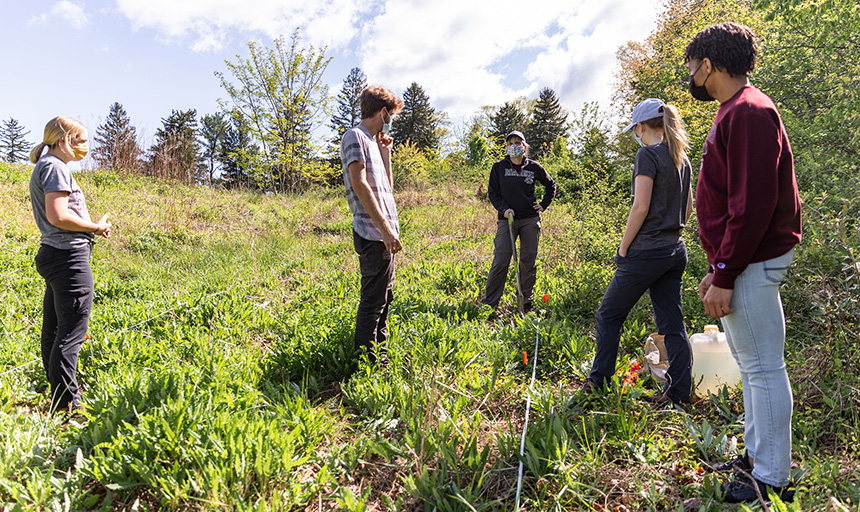Environmental riches
January 05, 2022

For Brittany Belcher ’22, summer included facing her fear of ticks while trudging through six-foot-tall grass to better understand stormwater management. For Bryce Blake ’22, summer days involved assessing and tagging native species of trees to develop a cultivation plan. For Da’Vaun Lee ’22, summer meant collecting and studying earthworms to learn more about soil health. The summer experience for Kristen Privette ’22 included field exploration to learn about the lively insect population scurrying below her feet.
While many students opt for relaxing summer days spent at the beach, this group of students embarked on the beginnings of establishing Roanoke College’s first large-scale environmental studies endeavor: an Environment Center at the College’s Elizabeth Campus.
Elizabeth Campus, located less than a mile from Roanoke’s main campus, provides ancillary support to the College, accommodating residential facilities, athletic fields, tennis courts and one classroom space. Construction debris from the Bowman Hall demolition in 2014 also occupies an area of the grounds.
The campus, which will remain active throughout the duration of the project, is also home to what Dr. Laura Hartman, associate professor of environmental studies, calls an “underutilized goldmine.”
“Elizabeth Campus is rich with animal and plant life,” Dr. Hartman said. “It is my hope that through this work, we can restore and preserve the land for many years to come.”
The initial conception of the project was developed by Hartman’s fall 2020 semester ENST 430 Environmental Practicum course. The class, consisting of 17 students majoring in environmental studies, determined that while Elizabeth Campus was functioning well for student life, there was an opportunity to rehabilitate functionality for the plants and animals that also call Elizabeth Campus home.
The class, under Hartman’s guidance, conducted baseline research throughout the fall 2020 semester on plant, animal and insect species living on 10 underutilized acres at Elizabeth Campus. They determined that the area was suitable for restoration, and continued research in community ecology, restoration ecology, urban ecology, hydrology, soil science and environmental monitoring.
It is my hope that through this work, we can restore and preserve the land for many years to come.
Dr. Laura Hartman, associate professor of environmental studies
Hartman credits her students with the project’s initial vision and passion, but she recognized that there was benefit to a broader, interdisciplinary approach. Because COVID-19 health guidance limited the typical social interaction needed for research and outreach, Hartman was restricted in utilizing community partners, the approach she typically takes with larger research projects.
So, she called upon her Roanoke College colleagues, specifically Dr. Katherine O’Neill, associate professor of environmental studies; Dr. Chelsea Peters, assistant professor of environmental studies; and Dr. Rachel Collins, associate professor of biology, to help propel the concept into a full-scale endeavor.
Dr. Collins, though, needed a bit of convincing.
“Initially, in August [2020], when I went to Elizabeth Campus and saw the land the students wanted to restore, I saw this wasteland of invasive species,” said Collins, whose specialty is in forest ecology. “However, in November [2020], I went to the presentation that the [Environmental Practicum] students gave on their vision of the Environment Center, and they made me see their vision. I was all in, and I immediately thought, ‘We can do this!’”
With Hartman’s expertise in environmental humanities, Collins’s understanding of terrestrial ecology, O’Neill’s proficiency in soil ecology, and Peters’s mastery in hydrology, the group banded together to present a proposal to the Buildings and Grounds Committee of the Roanoke College Board of Trustees in December 2020. It was because of the faculty members’ shared vision, clear messaging, and the Environmental Practicum students’ initial research that the proposal received the committee’s support.
“Not only do we work well together, but our research areas are super complementary,” said Collins. “I see so much synergy from how the four of us are interacting that our students feed off it and are able to learn not just about their area of interest but also other disciplines.”
Hartman echoed Collins’s support of an interdisciplinary approach since “environmental issues are complex.”
“My colleagues are powerhouses,” said Hartman. “I knew we needed their perspective to show students that they need to think in different ways. It is really important for students to be able to integrate different ways of thinking from different disciplines to solve these complex environmental problems.”
To read the full version of the story, please click here and turn to page 18.